Thuja, commonly known as arborvitae, is a versatile and attractive evergreen shrub that’s popular in gardens and landscapes for its vibrant green foliage and the privacy it provides. While planting Thuja from seeds is one option, propagating them from cuttings is an accessible and efficient method that allows anyone, regardless of their gardening expertise, to expand their Thuja collection or create a beautiful hedge. In this article, we’ll guide you through the process of propagating Thuja from cuttings, and you’ll see that anyone can do it with a little patience and the right steps.
Selecting the Right Time and Tools
Propagation of Thuja from cuttings is most successful during the plant’s active growth period, which typically occurs in late spring or early summer. Here’s what you’ll need to get started:
Select Healthy Parent Plant: Choose a healthy Thuja plant with strong, disease-free branches. Look for a branch that’s neither too young nor too old, as the best cuttings come from semi-hardwood growth, typically found on the current year’s growth.
Sharp Pruners or Shears: To take clean and precise cuttings, you’ll need a pair of sharp pruners or shears. Make sure they are clean to avoid introducing any potential pathogens to the cutting.
Rooting Hormone: While not always necessary, using a rooting hormone can significantly increase your success rate. It encourages the cutting to develop roots more quickly.
Potting Mix: Choose a well-draining potting mix or make your own mix by combining peat moss, perlite, and vermiculite.
Pots or Containers: You’ll need small pots or containers to plant the cuttings in.
Taking the Cuttings
Choose the Right Cuttings: Select branches that are around 4-6 inches long, and make the cut just below a node (the small bump where leaves and branches emerge). Cut at a 45-degree angle to create a clean, sharp end that allows for better water absorption.
Remove Lower Leaves: Strip the lower leaves from the cutting, leaving only a couple of sets of leaves at the top.
Apply Rooting Hormone (Optional): Dip the cut end of the cutting in rooting hormone to encourage root development.
Planting and Caring for Cuttings
Prepare the Potting Mix: Fill your pots or containers with the potting mix, making sure it’s moist but not waterlogged.
Insert the Cuttings: Use a stick or pencil to create a small hole in the potting mix and insert the cutting with the cut end down. Ensure that at least one node is beneath the soil.
Water and Cover: Water the cuttings gently and cover them with a plastic bag or plastic wrap to create a mini-greenhouse effect. This helps maintain humidity and temperature, crucial for root development.
Place in Indirect Light: Position the pots in a location with indirect light to avoid direct sunlight, which can scorch the young cuttings.
Maintain Humidity and Moisture: Check the soil regularly to keep it consistently moist but not waterlogged. If you notice condensation on the plastic covering, it’s a sign of sufficient humidity.
Transplant: After a few weeks to a couple of months, your cuttings should start developing roots. You can test this by gently tugging on the cutting – if it resists, it has rooted. Once they’re ready, transplant the rooted cuttings into larger pots or into your garden.
Patience and Perseverance
Propagating Thuja from cuttings is a straightforward process, but it does require patience. Not all cuttings will root successfully, so don’t be discouraged if you encounter some failures. With persistence and a bit of care, you’ll be rewarded with healthy Thuja plants that you can enjoy in your garden or landscape, and you’ll come to appreciate just how easy it is for anyone to propagate these lovely evergreens.






Add comment